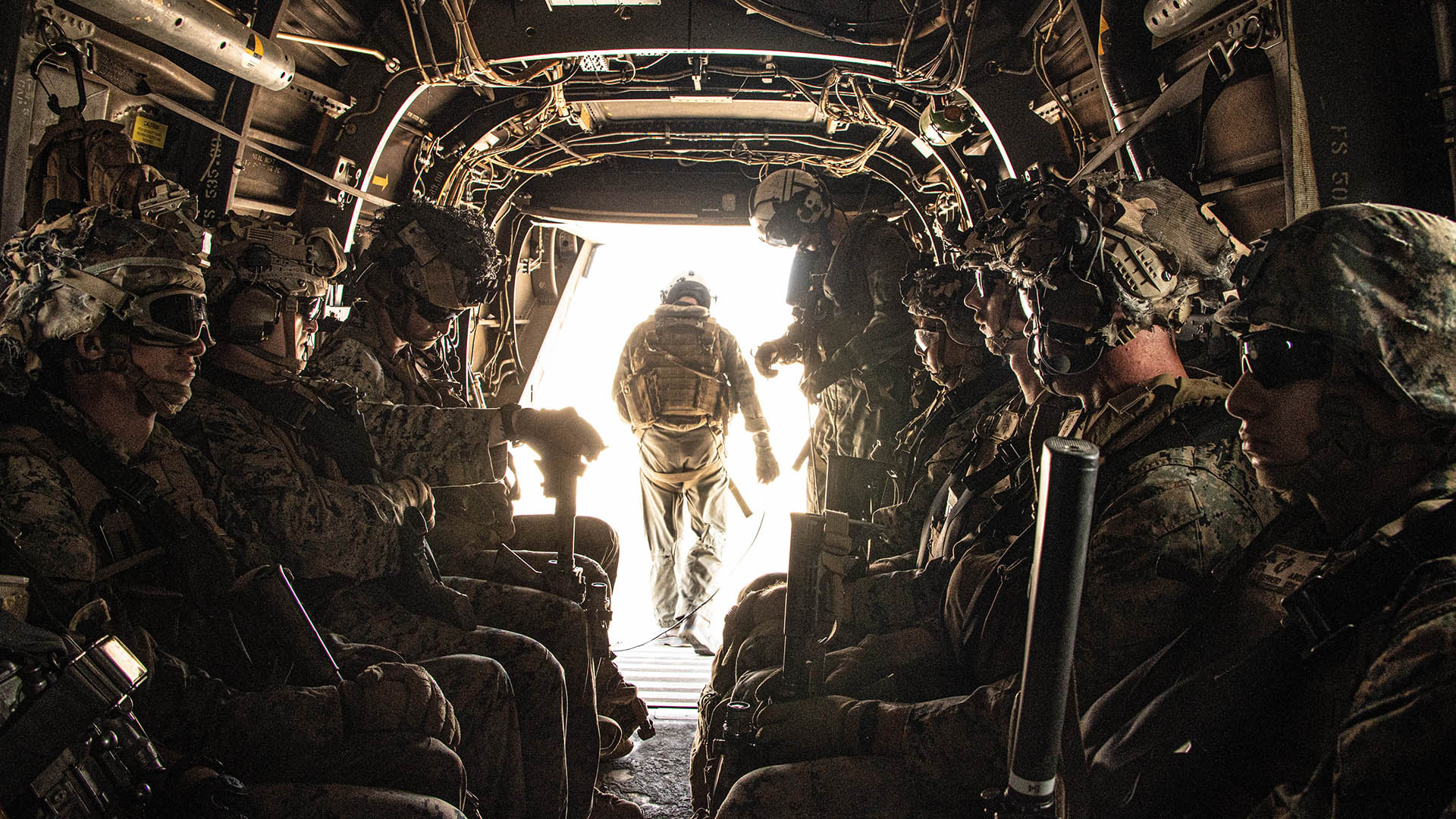
A historic Marine infantry battalion, whose regimental colors were burned prior to their capture during World War II and was then reforged from one of the Corps’ first Marine Raider units, will be remade again as part of the Marine Corps’ force structure changes that focus on China and the Pacific.
On Friday, 1st Battalion, 4th Marines will hold a redesignation ceremony at Camp Pendleton, California, so that the unit can become part of the 12th Littoral Combat Team, said Capt. Kristine Doan, a spokesperson with the 1st Marine Division.
The term “redesignating” means that the battalion is becoming a new unit, not deactivating, Doan told Task & Purpose. The littoral combat team will eventually move to Okinawa, Japan.
“The battalion’s colors will be ceremoniously rolled up and delivered to the United States Marine Corps History Division,” Doan said. “[Twelfth] Littoral Combat Team will hold its own ceremony at a later time to formally acknowledge their relocation.”
The new littoral combat team will have its own colors and be incorporated into the 12th Marine Littoral Regiment, which will fall under the 3rd Marine Division, III Marine Expeditionary Force, Doan said.
“The [Littoral Combat Team] is organized, trained, and equipped to support sea control and sea denial operations within actively contested maritime spaces as part of a modernized force integrated with the U.S. Navy, other elements of the Joint Force, and allied and partnered forces,” Doan said.
Burning the colors
The battalion initially stood up in 1911 as 1st Battalion, 4th Marine Regiment, and the unit’s first combat deployment was to the Dominican Republic in November 1916, according to the unit’s official history. First Lieutenant Ernest C. Williams became the battalion’s first Medal of Honor recipient for leading a charge that captured a fort at San Francisco de Macoris.
From 1927 to 1941, the 4th Marine Regiment was stationed in Shanghai, China, during which the battalion earned the title “China Marines.” For the first two years of its tour there, the regiment fell under the 3rd Marine Brigade, which was led by legendary Marine Brig. Gen. Smedley D. Butler, who returned to the United States in 1929.
The battalion left China for the Philippines along with the rest of the 4th Regiment in late November 1941, just before the Japanese attack on Pearl Harbor. For five months, the Marines fought against Japanese troops in the Bataan Peninsula and finally on the island of Corregidor in Manila Bay.

Around 800 Marines with the regiment fought tenaciously on Corregidor along with thousands of U.S. soldiers, sailors, and Philippine Scouts, but they had little food and water, no heavy guns, and were near the end of their supplies of ammunition. U.S. Army Lt. Gen. Jonathan Wainwright, who also feared the Japanese would massacre 1,000 sick and wounded personnel, surrendered U.S. and Filipino forces to the Japanese on May 6, 1942.
After the surrender, the Marines at Corregidor were ordered to burn all national and regiment colors, according to “From Shanghai to Corregidor: Marines in the Defense of the Philippines,” by J. Michael Miller.
Upon hearing that the colors had been burned, Miller wrote, Marine Col. Samuel L. Howard, who led the 4th Regiment at the time, put his face into his hand and wept, saying, “My God, and I had to be the first Marine officer ever to surrender a regiment!”
The regiment had lost 250 Marines in the fighting, but hundreds more died while in Japanese captivity, according to the National Museum of the Marine Corps.
The battalion is reborn
With the surrender of all U.S. troops in the Philippines, the battalion temporarily ceased to exist. Then, in February 1944, the 1st Marine Raider Battalion was redesignated as 1st Battalion, 4th Marines. The Raiders had fought in the Guadalcanal Campaign two years earlier and took part in the Battle of Edson’s Ridge in September 1942, during which Marines fended off waves of Japanese troops over two days. Col. Merritt Edson and Maj. Kenneth Bailey were both awarded the Medal of Honor for their leadership during the battle. Bailey’s award was posthumous.
The reborn battalion adopted the motto “Hold the High Torch” to honor the 4th Regiment Marines who were captured at Corregidor, and it went on to fight at Guam and Okinawa. Cpl. Richard Bush was awarded the Medal of Honor for leading an assault on Okinawa, during which he was seriously wounded, and used his body to shield other Marines from a grenade.
The battalion deployed to Vietnam from 1965 to 1969 and fought in places such as the Rockpile, Camp Carroll, Con Thien and Vandergrift Combat Base. Cpl. Larry Maxam and Pfc. Douglas Dickey were both posthumously awarded the Medal of Honor for giving their lives to save their fellow Marines.
After the war, the battalion participated in the May 1975 operation to rescue the container ship SS Mayaguez from the Khmer Rouge, during which 41 U.S. service members were killed.
The battalion took part in the first Persian Gulf War in 1990 and 1991 and then in March 2002 the unit served as a reserve force for combat operations in Afghanistan.
Starting in March 2003, 1st Battalion, 4th Marines was part of the invasion of Iraq, fighting at Nasiriyah, Al Kut and Bagdad. The unit returned to Iraq in May 2004 and fought insurgents at Najaf. The battalion deployed to Iraq twice more from 2006 to 2009, serving in Al Qaim Fallujah. In February 2009, 1st Battalion, 4th Marine Regiment was the last Marine infantry battalion to leave Iraq.
When the battalion is designated as the 12th Littoral Combat Team, it will continue to train and evolve to be ready to fight, Doan said.
“This redesignation reflects the Corps’ continued effort to ensure that Marines will remain capable of fighting and winning on the battlefields of the future, should the need arise,” Doan said.
